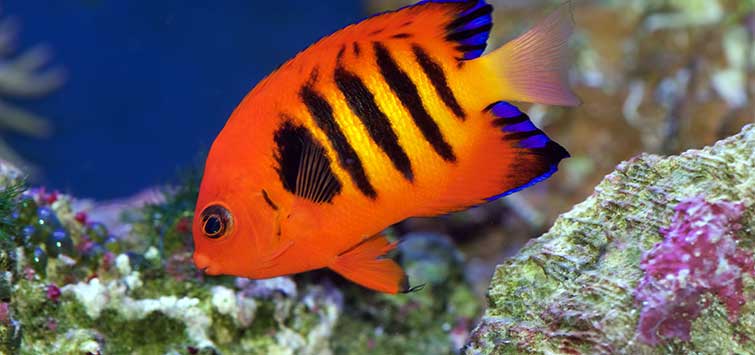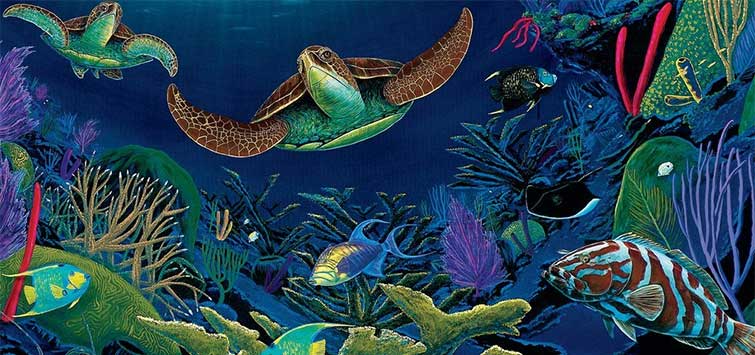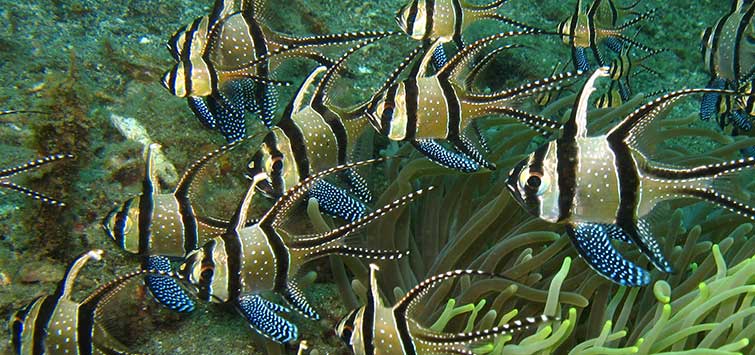A Marine Aquarium in Progress, Part 3: Challenges and Triumphs
Author: Jeff Kurtz
In the last installment, we left off with the transfer of three fishes (a longnose butterflyfish, a pearlscale butterflyfish, and a flame angelfish) from quarantine into my new 125-gallon FOWLR tank. In this final installment I’ll share the challenges and triumphs I experienced as livestock introductions progressed, and the tank—at long last—began to spring to life.
So Far, So Good
Now eating well and thankfully showing no further symptoms of ich, the butterflyfish and flame angelfish settled right into their new, much more spacious quarters. They began to explore their surroundings, nipping continually at the live rock and peering inquisitively into every nook, cranny, and crevice in search of edibles. After being confined to the 29-gallon quarantine tank for much longer than expected, they really seemed to appreciate the greatly enhanced space and swimming area of their new 125-gallon home.
I found it pleasing to see that the unsightly brown diatoms that had coated the rocks, substrate, and glass were giving way to an attractive patina of pink and purple coralline algae. I know it’s just a part of the natural progression of algae that occurs as a new aquarium matures, but I always find it discouraging when those grungy diatoms take hold—it’s sort of like stepping in a mud puddle with a brand new pair of white tennis shoes!
Buoyed by the successful introduction of the first three specimens, I began to rotate the various fishes in my stocking plan through a month-long quarantine, which were then transferred into the main tank. I kept my plan pretty flexible and always had alternate species in mind, so if any of the fishes on my list proved hard to find (which is not uncommon in Toledo, Ohio), I could readily make substitutions.
A Dodgy Situation
Stocking continued with the introduction of a sixline wrasse Pseudocheilinus hexataenia. Being a smaller specimen, I worried that the flame angel might bully it, but my concerns were unfounded. While the angelfish did give chase to the newcomer at first, the little sixline wrasse is so fast and maneuverable that it could easily dodge these rather sorry attempts at aggression. By the time the angelfish would reach the wrasse’s last known location, the wrasse would already be on the other side of the tank, seemingly having already forgotten that it was even being chased.
In one comical instance, the angelfish chased the wrasse into a hole in the live rock that was just large enough to accommodate the wrasse, but not the bulkier angelfish. In Tom-and-Jerry-like fashion, the angelfish plowed headfirst into the rock as the wrasse emerged, utterly unconcerned, from a different hole in the same rock. Fortunately (for the angelfish, anyway), I doubt that fish are capable of feeling embarrassment.
Send in the Clown and Jawfish
Clownfish
My next acquisition was a tomato clownfish Amphiprion frenatus and yellow-headed jawfish Opistognathus aurifrons. The clownfish promptly took up residence beneath a live rock ledge at one end of the tank and adopted one upper corner of the tank adjacent to my wet-dry overflow for its nighttime quarters. One morning, I found the clownfish trapped (but otherwise unharmed) inside the overflow chamber. Apparently, it had been startled at some point in the night or early morning and leapt over the rim of the chamber. To prevent such entrapments in the future, I moved the plastic lid from the outside overflow chamber to the inside chamber. I had to flip it upside down so that the U-shaped siphon tube would line up properly with the notch in the lid.
Jawfish
The jawfish is just loaded with personality and is, far and away, my favorite fish of the bunch. I can sit and watch it by the hour as it bobs in and out of its burrow in the substrate, sizing me up with its bulbous, bug-like eyes. One of its more amusing behaviors is striking out in almost snake-like fashion at tankmates that hover too close to its burrow. This happens with some regularity to the pearlscale butterflyfish, and each time it does, the butterflyfish seems to be caught completely off guard and looks back to see what happened—much the same way people do after tripping on a crack in the sidewalk. Since the jawfish always retreats with lightning speed deep into its burrow after it strikes, the butterflyfish never seems to figure out what hit it.
Feeding Challenge
The biggest challenge (if you want to call it that) to keeping the jawfish is making sure it gets its share of the food. Since it won’t venture far from the safety of its burrow in pursuit of a meal, I have to deliver food with a turkey baster just up-current of the burrow so that it drifts within easy grabbing distance. Of course, it didn’t take long for the rest of the fish to figure out that the long white tube protruding into the water delivers food (they’ll even nip at the tip of the baster to see if that will somehow cause it to expel its contents). So before feeding the jawfish, I have to distract the other fishes by squirting some food toward the opposite end of the tank, which only holds them off for a few seconds.
The Grass Is Always Greener
Jawfishes must be of the philosophy that “the grass is always greener in a different burrow,” because my specimen frequently abandons one burrow, then digs another. However, it’s fairly easy to discern the location of its new burrow from the pile of pristine substrate that appears in another part of the tank shortly after the previous site has been abandoned. The only time this behavior is problematic is when the new burrow happens to be located in a spot that’s difficult to reach with the turkey baster for feedings.
More Ich, and One Departure
Next in the order of introductions were a Wheeler’s shrimp goby Amblyeleotris wheeleri and a schooling bannerfish Heniochus diphreutes. The shrimp goby was actually a choice from my list of alternates. I originally planned to include a brownbarred goby Amblygobius phalaena in my lineup, but I was having no luck whatsoever in locating one. But no worries, because the Wheeler’s shrimp goby certainly has its own virtues! The bannerfish was definitely on my primary wish list though, and I was absolutely thrilled when I happened upon a really nice-looking specimen at my favorite local aquarium store.
Both specimens were soon in my quarantine tank, but alas, trouble reared its ugly head again. Since grappling with the initial Cryptocaryon outbreak with the first three fish I purchased, I’d had an easy run of it. All the other fish had gone through quarantine with no sign of disease. Unfortunately, my luck ran out with the bannerfish and goby. Both took to eating right away, but in just a few days, the bannerfish began twitching and scraping its body against the rocks. The goby didn’t manifest these symptoms, but it did stop eating, so I resumed the regimen of freshwater dips and water changes that had been effective at curing the butterflyfishes and angelfish.
A Scare
During the initial freshwater dip, I saw three or four cysts swell up and drop off the bannerfish. To my surprise, the goby—a relatively disease-resistant species—was affected far worse. No fewer than 20 cysts fell from its small, slender body. No wonder it had stopped eating! As before, the freshwater dips and copious water changes were effective at halting the ich outbreak, and four weeks after the symptoms stopped, I moved the goby and bannerfish to the main tank.
Trouble with Bannerfish
The goby settled into its new residence without any problems, but, unfortunately, the same can’t be said for the bannerfish. Right away, the flame angelfish and pearlscale butterflyfish took issue with the bannerfish, chasing it in tight circles and nipping at it from underneath. The attacks were occasional and short in duration at first, so I thought I’d give it a few days to see if things settled down once a pecking order was established.
The attacks continued, however, and they intensified to a point where a small chunk had been bitten out of the bannerfish’s long dorsal filament. This was the final straw. I carefully considered all of my options (returning the bannerfish, returning the two aggressors, or trying to break the cycle of aggression by temporarily removing the aggressors to the quarantine tank and reintroducing them later) and decided that the least disruptive option would be to return the bannerfish. Ah well, better to return the fish while it was still healthy (albeit somewhat battered), than to find it dead later on.
Inverts Introduced
Having reached my desired stocking level for fish (well, I might add a few more down the road, but seven will do for a start), it was time to spice things up a bit by adding a few motile invertebrates to the system. I had already introduced a handful of red-legged hermit crabs and about a dozen turbo snails to aid in algae control, but the tank still needed something. Being a big fan of cleaner shrimps and wanting something to help keep the top layer of substrate stirred a bit, I decided to add a white-banded cleaner shrimp Lysmata amboinensis and a serpent star Ophioderma sp. to the system.
In no time, the fish were presenting themselves to the shrimp for the advantage of their cleaning services, “advertised” via the bold red and white stripes along their backs. The shrimp also clambers over my hand whenever I place it nearby, and I can even feed it in this manner by pinching some food between my thumb and forefinger. As it picks at my fingers, it soon comes across the food and “goes to town” eating it.
Shrimp Relationships
Though shrimp gobies form symbiotic partnerships with burrowing alpheid shrimps (pistol shrimps) in nature, they do not form such relationships with cleaner shrimps. Interestingly, my shrimp goby always stays in very close proximity to the cleaner shrimp in my tank—perhaps it feels more at home in the presence of a shrimp. The shrimp frequently feels around inside the goby’s mouth to see if there’s anything worth eating in there. When it engages in this behavior, it always strikes me that the shrimp looks like a doting mother wiping dirt from her child’s face.
The Serpent Star
The lovely purplish-red serpent star stays out of sight most of the time, but the minute food enters the water, it rushes out of hiding to snatch any tasty tidbits that make it past the fish to the substrate. When introduced into the tank, the very first thing the serpent star did was unceremoniously settle into the jawfish’s burrow, which obviously did not sit well with the jawfish. Initially, it tried to accommodate the uninvited guest, hovering in the mouth of its burrow with the serpent star’s arms hanging out on either side of its head, but soon it had enough and began excavating a new burrow right next to the one now occupied by the serpent star. Adding insult to injury, as soon as the jawfish had put the finishing touches on its new burrow, the serpent star moved out of the old one.
I was worried that the serpent star was in danger of being damaged right after it was introduced, as several of the fish apparently mistook its quivering arm tips for worms. On the first day, the fish (especially, and not surprisingly, the flame angelfish and pearlscale butterflyfish) would nip at the poor thing’s arm tips whenever one happened to extend from beneath the rocks. Fortunately, the fish soon figured out that the arms aren’t edible after all and gave up their nipping.
Worth the Wait
Though almost a full year passed from the time I purchased the tank until it could be considered minimally stocked, I must admit that the result was well worth the wait—not to mention all the extra effort and persistence it took to treat ich-ridden fish. The tank is a constant source of interest. It remains a work in progress, but having the opportunity to enjoy the system as it continues to evolve is just part of the payoff.
See the full article on TFH Digital http://www.tfhdigital.com/tfh/200811/#pg99

.png?h=595&iar=0&w=2781&hash=5FD5E69473BCC22199FBFA2FB71B6033)



